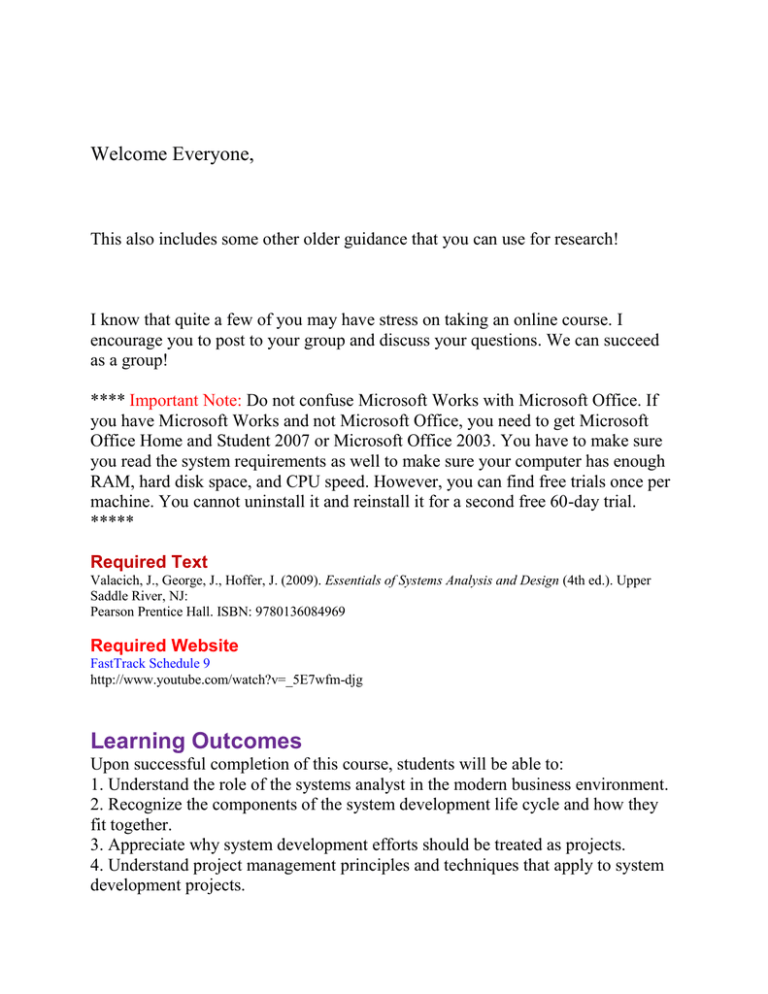
Welcome Everyone,
This also includes some other older guidance that you can use for research!
I know that quite a few of you may have stress on taking an online course. I
encourage you to post to your group and discuss your questions. We can succeed
as a group!
**** Important Note: Do not confuse Microsoft Works with Microsoft Office. If
you have Microsoft Works and not Microsoft Office, you need to get Microsoft
Office Home and Student 2007 or Microsoft Office 2003. You have to make sure
you read the system requirements as well to make sure your computer has enough
RAM, hard disk space, and CPU speed. However, you can find free trials once per
machine. You cannot uninstall it and reinstall it for a second free 60-day trial.
*****
Required Text
Valacich, J., George, J., Hoffer, J. (2009). Essentials of Systems Analysis and Design (4th ed.). Upper
Saddle River, NJ:
Pearson Prentice Hall. ISBN: 9780136084969
Required Website
FastTrack Schedule 9
http://www.youtube.com/watch?v=_5E7wfm-djg
Learning Outcomes
Upon successful completion of this course, students will be able to:
1. Understand the role of the systems analyst in the modern business environment.
2. Recognize the components of the system development life cycle and how they
fit together.
3. Appreciate why system development efforts should be treated as projects.
4. Understand project management principles and techniques that apply to system
development projects.
5. Describe the different approaches to system development (structured,
information engineering, and object oriented).
6. Understand the techniques for gathering system requirements.
7. Assess the basic models for documenting and modeling system requirements.
Academic Research
Academic research and papers must meet certain standards of quality recognized
by the academic community. What constitutes quality academic research?
Primary (original) sources written by experts in the field of study
Secondary sources supported by research in primary sources
Credible sources (experts in the area of study)
Relevant research (materials are pertinent to the area of study)
In graduate work. the use of peer-reviewed journal articles (journal articles
reviewed by recognized experts in the relevant field of study) is required
Educational websites may be appropriate in some cases but should be evaluated
carefully!
What sources are not acceptable for academic research and referencing?
Encyclopedias
Dictionaries
Wikipedia, other wikis, or blogs
Websites and other sources that do not provide quality researched materials
(site does not use credible sources to support the information in the
document)
*Remember: There is no one standard life cycle model and the model that you will rely on
when you begin work as a systems analyst will likely differ from the life cycle model in the
text. The life cycle represents activities that must be done, and the phases are a way to
introduce, in an organized way, the methods, techniques, tools, and skills necessary for
successful systems analysis and design.
Chapter 1:
What Is Information Systems Analysis and Design?
All organizations have information systems, and use them for operational, tactical, and strategic
advantage. For information systems to remain effective, these systems must efficiently capture,
store, process, and distribute information according to business objectives. To properly
maintain these systems, systems analysts will perform information systems analysis and
design. Information systems analysis and design is based on an understanding of the
organization’s objectives, structure, and processes, as well as the analyst’s knowledge of how
to exploit information technology for competitive advantage.
Systems Analysis and Design: Core Concepts
Improving organizational information systems is the major goal of systems analysis and design.
illustrates the four systems development life cycle phases. Although a systems analyst’s primary
role is application software development, an analysis of the other computer-based information
systems components is warranted.
As
shows, these components include hardware, controls, specific job roles, users of the system,
system software, and documentation and training manuals.
Methodologies, techniques, and tools are central to the software engineering process.
Systems
System is a group of interrelated procedures used for a business function, with an identifiable
boundary, working together for some purpose.
A system has nine characteristics. The nine characteristics are: components, interrelated
components, boundary, purpose, environment, interfaces, input, output, and constraints.
Types of Information Systems and Systems Development
illustrates that an organization has three classes of information systems:
transaction processing systems (TPS)
management information systems (MIS)
decision support systems (DSS).
Developing Information Systems and the Systems Development Life Cycle
Organizations use a systems development methodology to develop and support their
information systems. A systems development life cycle (SDLC) is a common methodology for
systems development, and each organization will use a slightly different version. The life cycle
presented in the textbook has four phases: (1) systems planning and selection; (2) systems
analysis; (3) systems design; and (4) systems implementation and operation.
illustrates these phases.
Systems planning and selection has two primary activities: (1) identifying a potential project
and (2) investigating the system and determining the proposed system’s scope.
Systems analysis consists of three subphases: requirements determination, requirements
structuring, and alternative generation and selection.
Systems design, the third life cycle phase, has two primary activities: logical design and
physical design. If
the Systems planning is done correctly, this will be
your shortest phase! If phase 1 and 2 are not done correctly, you
will continually re-design!
Approaches to Development
This chapter discusses six approaches to systems development. These approaches are:
prototyping
Computer-aided software engineering (CASE) tools
Joint application design (JAD) Personal Favorite! brings users, managers, and analysts
together for several days in a series of intensive meetings
Rapid application development (RAD) – screens or formal are built to get users
compliance
Participatory design (PD) - has as its central focus users and the improvement of their
work lives
Agile Methodologies.- focus on adaptive methodologies, people instead of roles, and a
self-adaptive process.
Chapter 2:
Systems Acquisition
Considering how important information systems are to organizations, when did they begin to be
used, and where did they come from? GE produced an in-house payroll option in 1954. Since
then, in-house development has become a smaller component of many organizations’ systems
development budgets as other sources of software have become available and more
strategically advantageous than developing software in-house.
Outsourcing
Outsourcing is a practice where another organization develops or runs a computer application
for your organization. Outsourcing can be very cost effective, and many organizations choose to
outsource much, if not all of their IT functions.
Sources of Software
Methods of acquiring software can be grouped into 6 major categories—
(1) information technology services firms
(2) packaged software providers
(3) vendors of enterprise solution software
(4) application service providers and managed service providers
(5) open-source software
(6) in-house development
Choosing Off-The-Shelf Software
If an analyst chooses to purchase software, s/he should understand what criteria they should
evaluate before making a decision, and how to compare the options available to them.
Two types of software
Turnkey – cannot be modified to meet specific users needs
Non-turnkey – can be modified
Another important consideration when evaluating off-the-shelf options is validating the software
information. This can be done by asking the vendor, but can also be carried out by issuing a
Request for Proposal (RFP), where vendors can propose hardware and software that will meet
the requirements of your new system. Other users of the software are also good sources for
feedback and validation.
Reuse
In addition to the sources of software already identified, some organizations may be able to
Reuse software, or various components from already developed software. Reuse may apply to
many pieces of previously developed software, but most often applies to object-oriented and
component-based technologies. Reuse requires the organization to be able to leverage the
cost of components across many users and projects.
Four Approaches
1. Ad hoc Reuse
2. Facilitated Reuse
3. Managed Reuse
4. Designed Reuse
ASSIGNMENTS:
Assignment
Post your
Introduction
Building a System
Selecting Software
Hoosier Burger
Case: Part1
Due
Date
Format
Point
Day 1
Discussion Forum
1
Day 3
(1st post)
Discussion Forum
3
Day 3
(1st post)
Discussion Forum
4
Day 7
Written Assignment
8
Learning Outcomes
This week students will:
Assess the “engineering” approach and the methodologies of systems
analysis and design.
Identify criteria for selecting off-the-shelf software.
Evaluate systems development for a business.
Readings
1. Read the following chapters in Essentials of Systems Analysis and Design:
a. Chapter 1: The Systems Development Environment
b. Chapter 2: The Sources of Software
Discussion Forums
Participate in the following Discussion Forums:
1. Due by Day 1. Introduction. Post your introduction on the discussion forum
titled, “Introductions” found in
Week One. Respond to at least three of your classmates’ postings.
2. 1st Posting Due by Day 3. Building a System. Why is it important to use
systems analysis and design
methodologies when building a system? Why not just build the system in whatever
way seems to be “quick and easy”? What value is provided by using an
“engineering” approach? Also, Give a specific example of an organization (not one
listed in the book) that does a good job of this and why. Respond to at least two of
your classmates’ postings.
3. 1st Posting Due by Day 3. Selecting Software. Review the criteria for selecting
off-the-shelf software
presented in this chapter. Use your experience and imagination and describe other
criteria that are, or might be used to select off-the-shelf software in the real world.
For each new criterion, explain how its use might be functional, dysfunctional, or
both. Respond to at least two of your classmates’ postings.
Assignment
1. Due by Day 7. Hoosier Burger Case: Part 1. Read the Hoosier Burger scenario
on page 28 in Chapter 1 of the text and address the following in a 1 to 3 page APA
style paper:
a. Apply the SDLC approach to Hoosier Burger.
b. Using the Hoosier Burger scenario, identify an example of each system
characteristic.
c. Decompose Hoosier Burger into its major subsystems.
d. Briefly summarize the approaches to systems development discussed in this
chapter. Which approach do you feel should be used by Hoosier Burger?







